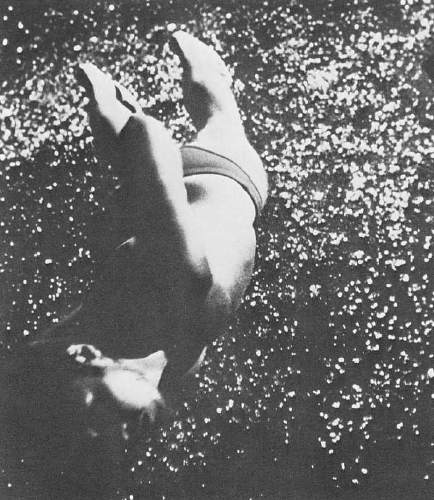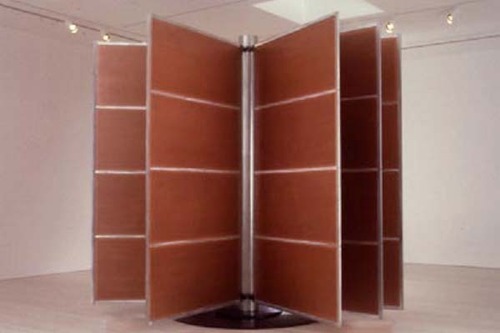
In 1973, Chris Burden bought a month worth of late-night ad time on a local TV station in Los Angeles, and aired a 10-second film clip of Through the Night Softly, a performance where Burden, clad only in bikini underwear, crawls across a parking lot full of broken glass with his hands behind his back.
Below is a video of Burden explaining the work, its background, and its reception. [It’s taken from a 35-min. compilation reel where the artist documents some of his performance pieces from 1971-4, which he exhibited in 1975. The whole thing is at UbuWeb.]
The poetic title, Through the Night Softly is mentioned in an intertitle in the commercial itself, but the piece is treated separately. Burden calls it “TV Ad,” and “TV Ad piece,” as in “The TV Ad piece came out of a longstanding desire to be on television.” Burden’s ad is preceded by a Ronco record ad and followed–almost too perfectly–by another naked guy, lathering up in a soap commercial.
In retrospect, Burden’s ideas for the piece are almost quaint. He wanted to be on “real TV,” which he defined at the time as “anything you could flip to on a dial. Anything else–cable, educational, video–was not real TV.”
And he also expressed “satisfaction” at knowing that 250,000 people a night would see his video “stick out like a sore thumb” and “know that something was amiss.”
The juxtapositions certainly look absurd, or surreal, anyway, but did the work really generate the cognitive dissonance Burden hoped for? The artist’s action in the film reminds me immediately of the kind of head-down, low army crawl that would have been a familiar experience for veterans–and a common sight from news coverage of Vietnam, the “First Televised War,” which was, by 1973, one of the longest-running shows on the air.
I haven’t really read much about Burden in terms of politically charged art, and his slightly self-absorbed narrations of these early, controversial pieces don’t betray any real hints of the political references–about crime, gun control. domestic violence, war, Vietnam–that have been ascribed to them.
Still, Burden made directly political work later on–the video I linked to yesterday shows him talking about The Reason for The Neutron Bomb (1979) and how he used 50,000 nickels and matchsticks instead of commissioning 50,000 toy tanks because being stuck with a garageful of toy tanks was as the same kind of crazy as amassing the real things on Europe’s border, just on a different scale.

And his 1992 work, The Other Vietnam Memorial, The giant copper Rolodex containing three million computer-generated Vietnamese names, representing the missing and killed–soldiers and civilians alike–who weren’t mentioned on Maya Lin’s walls, blew my mind when I saw it in 1992 at MoMA.
As Christopher Knight pointed out at the time [in the run-up and aftermath of what would later be renamed the First Gulf War], the power of Burden’s work lay in its contrast to the gut-wrenching personalization of The Vietnam Memorial, its unflinchingly cold acknowledgment of Americans’ general lack of interest in the specifics of the wars being fought in our name:
Transcending topical politics, the hoary conception of a Homogeneous Us versus an Alien Them allowed the fruitless slaughter. “The Other Vietnam Memorial” is as much an officially sanctioned tribute to American fear, ambition and loathing as it is to slain men and women. Its shocking moral ambivalence is the source of its riveting power.
It all makes me want to see a Burden retrospective on The Mall. Would the Hirshhorn or the National Gallery ever be up for the challenge? Come for the flying steamroller and the Erector set skyscrapers, stay for the excoriation of our national indifference to the predations of the Military Industrial Complex? Hmm, the pitch might need a little work.
